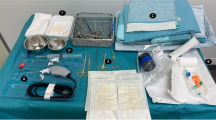Abstract
Purpose
Isolated tenotomy of the long head of the biceps (LHB) is known to improve function in patients with massive and non-reparable cuff tears without osteoarthritis.
This two step cadaveric study was performed with the purpose to identify the best surgical technique for isolated LHB tenotomy under USG guidance (pilot study) and evaluate its feasibility (subsequent study).
Methods
Pre-operative ultrasonographic evaluation of the rotator cuff was performed and any specimens whose long head of the biceps was not found to be intact during the pre-operative ultrasound evaluation were excluded. In the pilot study, nine scar-free cadaveric shoulders underwent ultrasound-guided tenotomy through a single percutaneous portal to determine the best instrument and approach which ensure elective and complete LHB tenotomy. Using it, a second series of 12 cadaveric shoulders were operated following a similar protocol to evaluate the feasibility of this technique.
Result
Pilot study: The use of a backward endoscopic cutter through a posterior percutaneous portal was found to be the safest. Control of the tenotomy was possible by manipulating the intra-articular part of the tendon with the instrument (“Groove Alone” test). Subsequent study: The tenotomy of the LHB was complete in all cases. Mean length of the proximal LHB stump was 0.3 cm (range, 0–0.8 cm). No iatrogenic lesion was observed when using the backward endoscopic cutter. On the other hand, the use of straight endoscopic scissors led to severe damage to the rotator cuff and the conjoined tendon. The “Groove Alone” test checked against iatrogenic injury. This was not done in one of the cases and it led to a partial section of the superior half of the tendon of the subscapularis.
Conclusion
By the use of both appropriate endoscopic instrumentation and the newly described “Groove Alone” test, ultrasound-guided LHB tenotomy through a single percutaneous portal appears to be a feasible and reliable procedure that could be an alternative to isolated arthroscopic tenotomy. The choice of a posterior portal (soft point) may increase the safety and precision of this procedure and decrease the length of the proximal stump of the LHB.



Similar content being viewed by others
References
Boileau P, Baqué F, Valerio L, Ahrens P, Chuinard C, Trojani C (2007) Isolated arthroscopic biceps tenotomy or tenodesis improves symptoms in patients with massive irreparable rotator cuff tears. J Bone Joint Surg Am 89(4):747–57
Hsu AR, Ghodadra NS, Provencher MT, Lewis PB, Bach BR (2011) Biceps tenotomy versus tenodesis: a review of clinical outcomes and biomechanical results. J Shoulder Elb Surg 20(2):326–32
Lim TK, Moon ES, Koh KH, Yoo JC (2011) Patient-related factors and complications after arthroscopic tenotomy of the long head of the biceps tendon. Am J Sports Med 39(4):783–9
Maynou CMN, Cassagnaud X, Audebert S, Mestdagh H (2005) Clinical results of arthroscopic tenotomy of the long head of the biceps brachii in full thickness tears of the rotator cuff without repair: 40 cases. Rev Chir Orthop Reparatrice Appar Mot 91(4):300–6
Shank JR, Singleton SB, Braun S, Kissenberth MJ, Ramappa A, Ellis H et al (2011) A comparison of forearm supination and elbow flexion strength in patients with long head of the biceps tenotomy or tenodesis. Arthroscopy 27(1):9–16
Szabó I, Boileau P, Walch G (2008) The proximal biceps as a pain generator and results of tenotomy. Sports Med Arthrosc 16(3):180–6
Walch G, Edwards TB, Boulahia A, Nové-Josserand L, Neyton L, Szabo I (2005) Arthroscopic tenotomy of the long head of the biceps in the treatment of rotator cuff tears: clinical and radiographic results of 307 cases. J Shoulder Elb Surg 14(3):238–46
Lévy B, Ducat A, Gaudin P, Maqdés A, Brasseur JL, Klouche S et al (2012) Ultrasound-guided percutaneous tenotomy of the long head of the biceps tendon: a non-reliable technique. Knee Surg Sports Traumatol Arthrosc 20(6):1027–30
Aly AR, Rajasekaran S, Mohamed A, Beavis C, Obaid H (2014) Feasibility of ultrasound-guided percutaneous tenotomy of the long head of the biceps tendon—A pilot cadaveric study. J Clin Ultrasound 43(6):361–366
Greditzer HG, Kaplan LD, Lesniak BP, Jose J (2014) Ultrasound-guided percutaneous long head of the biceps tenotomy: a novel technique with case report. HSS J : Musculoskelet J Hosp Spec Surg 10(3):240–4
Brasseur JL (2012) The biceps tendons: from the top and from the bottom. J Ultrasound 15(1):29–38
Farin PU (1996) Sonography of the biceps tendon of the shoulder: normal and pathologic findings. J Clin Ultrasound 24(6):309–16
Middleton WD, Reinus WR, Totty WG, Melson CL, Murphy WA (1986) Ultrasonographic evaluation of the rotator cuff and biceps tendon. J Bone Joint Surg Am 68(3):440–50
Teefey SA, Hasan SA, Middleton WD, Patel M, Wright RW, Yamaguchi K (2000) Ultrasonography of the rotator cuff. A comparison of ultrasonographic and arthroscopic findings in one hundred consecutive cases. J Bone Joint Surg Am 82(4):498–504
Checcucci G, Allegra A, Bigazzi P, Gianesello L, Ceruso M, Gritti G (2008) A new technique for regional anesthesia for arthroscopic shoulder surgery based on a suprascapular nerve block and an axillary nerve block: an evaluation of the first results. Arthroscopy 24(6):689–96
Nam Y-S, Jeong J-J, Han S-H, Park S-E, Lee S-M, Kwon M-J et al (2011) An anatomic and clinical study of the suprascapular and axillary nerve blocks for shoulder arthroscopy. J Shoulder Elb Surg 20(7):1061–8
Acknowledgments
The authors warmly thank Mr Luc d’Asnières de Veigy (Monte-Carlo Joint Repair, Monaco) and the Ecole de Chirurgie du Fer à Moulin (APHP, Paris).
Author information
Authors and Affiliations
Corresponding author
Electronic supplementary material
Below is the link to the electronic supplementary material.
Rights and permissions
About this article
Cite this article
Atlan, F., Werthel, J.D. Ultrasound-guided intra-articular tenotomy of the long head of the biceps: a cadaveric feasibility study. International Orthopaedics (SICOT) 40, 2567–2573 (2016). https://doi.org/10.1007/s00264-016-3231-2
Received:
Accepted:
Published:
Issue Date:
DOI: https://doi.org/10.1007/s00264-016-3231-2




